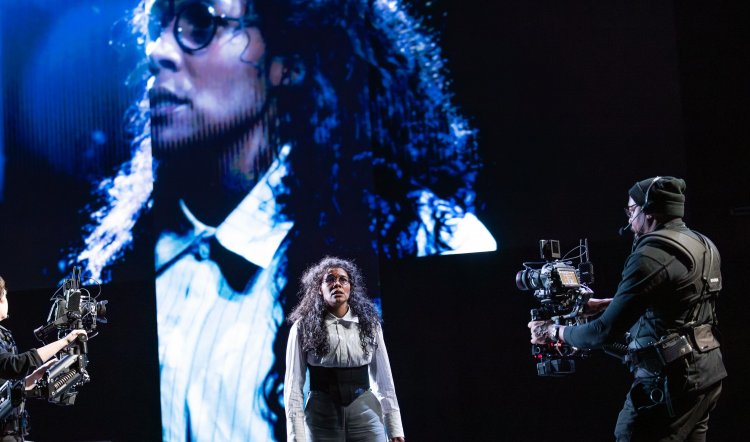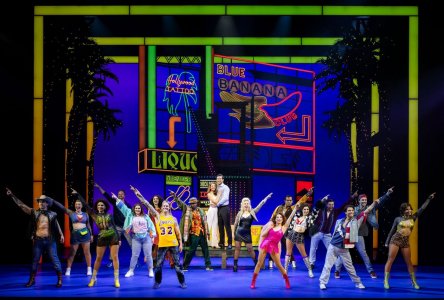
DRACULA
DRACULA, Sydney Theatre Company at the Roslyn Packer Theatre, 6 July-4 August 2024. Photography by Daniel Boud - above and below: Zahra Newman; below again: Newman, camera operators Lucy Parakhina and André Morton
Although adapter and director, Kip Williams, regards Dracula as the final element in a trilogy that began with The Picture of Dorian Gray and continued with The Strange Case of Dr Jekyll and Mr Hyde, one can’t ignore 2015’s Suddenly Last Summer as being the true genesis of Williams’ astonishingly complex video-live video-live theatre form.
While there’s a common thread of Victorian Gothic through the trilogy, there’s an equally powerful link to the Southern Gothic of Tennessee Williams’ play, and the spectacle of construction and deconstruction introduced by (Kip) Williams and his technical/creative team. Throughout each show the audience is presented with simultaneous pre-recorded segments, live video, and live performance. It reached unforgettable fruition in Suddenly Last Summer and has continued to the present production.
There is one crucial difference, however, and that lies in the quality of each play’s text. Bram Stoker is no Oscar Wilde (Dorian Gray), Robert Louis Stevenson (Jekyll and Hyde), or Tennessee Williams. A theatre manager by trade, Stoker wrote potboilers to supplement his income. Dracula was the seventh of these and it’s epistolary, which ought to lend itself to performance and would if it were better written. As it is, while a magnificent Zahra Newman takes on all 23 characters, plus immersion in hundreds of sound, visual, and lighting cues, surrounded by screens, structures, and prowling camera operators, the lumpen corn of the text becomes more and more obvious as the 110 minutes roll by.

Although Stoker probably didn’t intend it, Dracula was a big hit for him and – definitely not intentional – has ever since captured the imaginations of generations of theatre and film-makers. Most have read into it and then plundered many rich elements including psycho-sexual reasons for blood, its consumption, and its fanciful Victorian corollary of lesbian vampirism; even more reasons for exploring identity and its various crises including the blurring of three into one; there’s also possible, probable and improbable historical sources (not Elizabeth Bathory, nor Vlad the Impaler).
In the non-stop visual feast are fleeting references to past Vampires – including FW Murnau’s gloriously creepy Nosferatu of 1922; the Hammer Horror of 1958 and Christopher Lee’s cadaverous Count – and then there’s Zahra Newman herself. In video close-up and in person on stage, in and out of many costumes and genders, she is a dynamic and beautiful presence: everything one could desire in an irresistible vampire.
Curious then that in the main this Dracula is as sexy and appealing as yesterday’s goulash. And, despite the overwhelming heightened reality and synchronous unreality of stealthy vampires and vulnerable jugular veins, there is precious little fright, shock, or tension. Ironically, this is probably because there is way too much blood and way too many glistening fangs.

Steven Spielberg got it right with Jaws in figuring that it was much more frightening to not reveal the source of fear. Let audiences imagine the worst and goad them into scaring themselves half to death before having the shark leap out of the screen. In this Dracula, however, it’s blood-and-fangs-au-go-go to the point where the stabbing of the Count in his coffin, and the accompanying gushing blood, elicits laughter around the auditorium. Oops.
Excess blood aside, this Dracula is spectacular video-theatre. Designer Marg Horwell and lighting designer Nick Schlieper have exceeded themselves in fashioning space, shadows, clutter, and infinity around screens that rise, fall, and move to and fro. Composer Clemence Williams and sound designer Jessica Dunn combine to add vivid atmosphere, and it’s not their fault the nightmarish qualities they conjure up are not sustained elsewhere. Video designer Craig Wilkinson and the team of camera operators make for a densely populated one-woman show and their work is superb.
Yet Newman and the crew deserve better than a superficial pick-through of Bram Stoker’s novel which, like its anti-hero, refuses to die, no matter how much blood is sucked out. In the end, on opening night, the audience leapt to its feet in a heartfelt standing ovation. Newman deserved it – for a remarkable feat of technically-based performance and scarcely believable triumph of memory. At the same time, while the stage manager isn’t named in the program, s/he deserves all credit for flawlessly calling the many hundreds of cues in this monumental mechanical enterprise.
Comments
Leave a Comment
Enter your username and password to comment. Don't have a username? Register now.

-c444x300.jpeg)


Be the first to leave a comment below